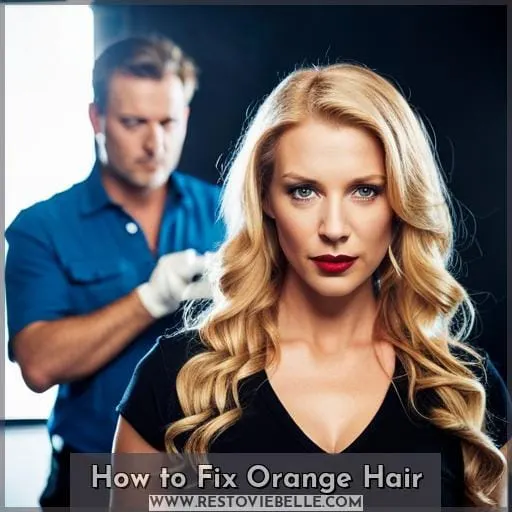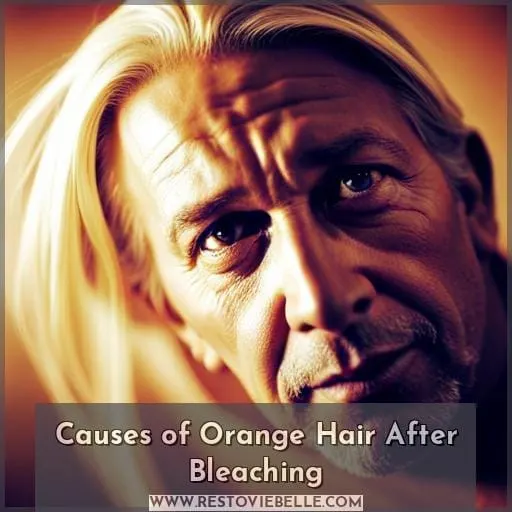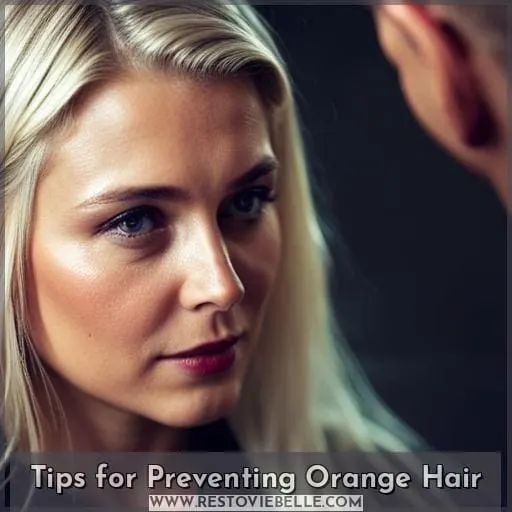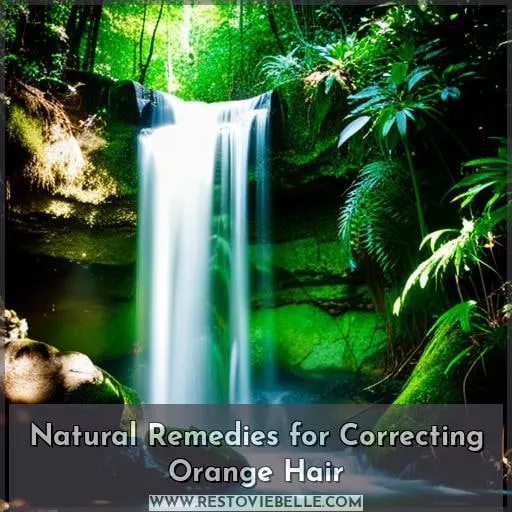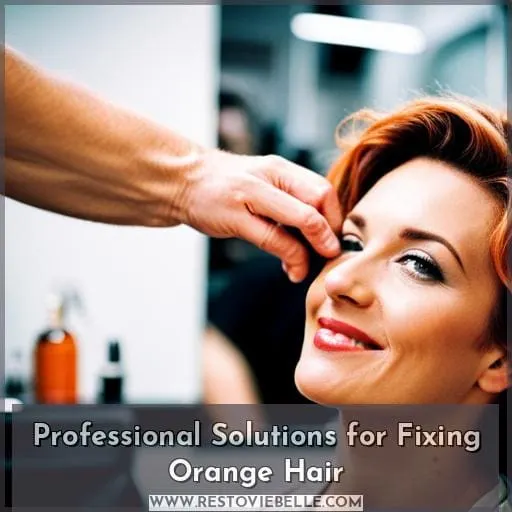This site is supported by our readers. We may earn a commission, at no cost to you, if you purchase through links.
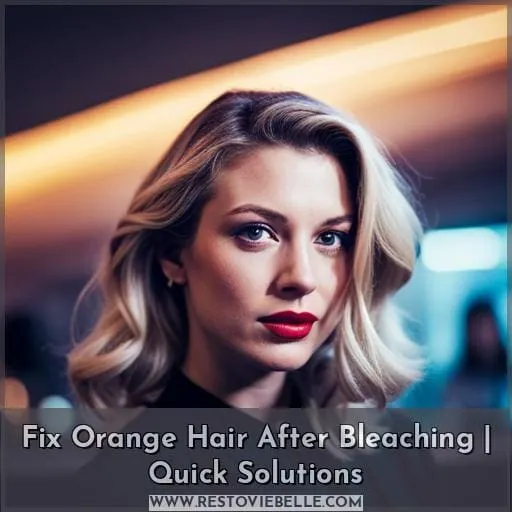 Picture this: you’ve just finished bleaching your hair, hoping for a stunning blonde transformation. But instead, you’re left with unwanted orange tones that make you cringe. Don’t panic! There are quick and effective solutions to fix orange hair after bleaching.
Picture this: you’ve just finished bleaching your hair, hoping for a stunning blonde transformation. But instead, you’re left with unwanted orange tones that make you cringe. Don’t panic! There are quick and effective solutions to fix orange hair after bleaching.
In this article, we’ll share expert tips and tricks on how to banish those brassy hues at home or with professional help.
Table Of Contents
- Key Takeaways
- How to Fix Orange Hair
- Causes of Orange Hair After Bleaching
- Tips for Preventing Orange Hair
- Natural Remedies for Correcting Orange Hair
- Professional Solutions for Fixing Orange Hair
- Frequently Asked Questions (FAQs)
- How long does it take for orange tones to show up after bleaching?
- Can I sleep with purple shampoo in my hair overnight to remove brassiness faster?
- Does using a clarifying shampoo help get rid of orange hues more effectively than regular shampoo?
- What ingredients should I look for in a hair mask or deep conditioner to target brassiness?
- If my hair turned orange after using box dye, will Color Oops or a color remover help lift the tones before re-coloring?
- Conclusion
Key Takeaways
- Use purple or blue toning shampoo to neutralize orange tones quickly.
- Dye your hair a darker shade for effective coverage of unwanted hues.
- Seek professional salon treatment for optimal and immediate results.
- Consider an apple cider vinegar toning rinse as a natural remedy.
How to Fix Orange Hair
To fix orange hair after bleaching, there are several effective solutions you can try.
One option is to use a purple or blue toning shampoo, which helps neutralize the orange tones and restore a more balanced color.
Another solution is to dye your hair a darker shade that can effectively cover up the unwanted orange hues.
If you prefer professional assistance, seeking salon treatment from an experienced stylist who specializes in color correction can provide optimal results.
Lastly, you may also consider trying an apple cider vinegar toning rinse as a natural remedy for reducing brassiness in your hair.
Use a Purple or Blue Toning Shampoo
You can easily correct orange hair after bleaching by using a purple or blue toning shampoo.
These shampoos work based on the principles of the color wheel, where purple tones neutralize orange and blue tones counteract yellow.
Additionally, you can try DIY remedies like homemade toning masks to maintain vibrant hair color for longer periods.
Dye Your Hair a Darker Color
To fix orange hair after bleaching, consider dyeing your hair a darker color. This is one of the most effective solutions for hiding unwanted orange tones.
There are various options available, including professional alternatives and DIY color removers. You can also explore natural lightening methods or experiment with alternative mask treatments to achieve the desired results.
Seek Professional Salon Treatment
If you’re dealing with orange hair after bleaching, seeking professional salon treatment is a smart move.
A salon consultation will allow an experienced stylist to assess your hair’s health and recommend the best course of action.
They can use professional techniques like toning or natural lightening methods to correct the orange hue effectively.
Don’t hesitate to explore alternative remedies under their guidance as well.
Try an Apple Cider Vinegar Toning Rinse
To fix orange hair after bleaching, consider using an apple cider vinegar toning rinse. This DIY toning method is highly effective due to the acidic properties of vinegar.
The acidic rinse helps restore pH balance and neutralize brassy tones, leaving your hair looking vibrant and natural. Vinegar benefits make it a popular choice for natural remedies in hair care routines.
Causes of Orange Hair After Bleaching
When you bleach your hair, there are several factors that can contribute to the appearance of orange tones.
- One common cause is residual pigments in darker hair, such as red and orange hues.
- Additionally, over-processing or insufficient bleaching can result in uneven color and an orange tint.
- Another factor to consider is mineral build-up from water exposure, which can lead to brassiness in lightened hair.
Residual Pigments in Darker Hair
When bleaching darker hair, it’s important to note that residual pigments can cause orange tones to appear.
Brunette pigments, such as red and orange, can linger in the hair even after the bleaching process. This dark hair residue contributes to brassiness and requires color correction techniques.
To reduce brassiness and correct orange hair, you can opt for professional salon treatments or try natural toning methods like apple cider vinegar rinses.
Over-Processing or Insufficient Bleaching
You may have over-processed or not bleached your hair enough if you’re experiencing orange tones after bleaching.
Properly assessing the health of your hair and using appropriate bleaching techniques are essential to avoid unwanted brassiness.
Consider consulting with a professional colorist who can provide expert advice on how to fix orange hair.
Additionally, preventive measures such as using quality bleach products and protecting your hair from chlorine and saltwater can help maintain vibrant, healthy-looking locks.
DIY remedies like hollyhock herbs or ACV rinses can also be effective in toning down brassiness naturally.
Mineral Build-Up From Water Exposure
If you don’t properly protect your hair from water exposure, mineral build-up can cause orange tones after bleaching.
To prevent this, consider using shower filter solutions to remove water minerals and prevent brassiness.
Aquatic hair care is crucial in maintaining the color of your bleached hair.
Explore hard water fixes to ensure that your locks stay vibrant and free from unwanted orange hues.
Take control of your post-bleaching routine by preventing mineral build-up for flawless results.
Tips for Preventing Orange Hair
To prevent orange hair after bleaching, it’s important to ensure proper bleaching techniques.
- Using quality bleaching products
- Avoiding over-processing your hair
- Protecting your hair from chlorine and saltwater
Ensure Proper Bleaching Techniques
To ensure proper bleaching techniques and prevent orange hair, follow these tips:
- Practice precision bleaching to minimize damage and achieve desired results.
- Optimal toning with purple or blue products helps neutralize unwanted tones.
- Prioritize hair health by using quality bleach and deep-conditioning treatments.
- Explore DIY techniques, but don’t hesitate to seek professional insight for best outcomes.
Use Quality Bleaching Products
Applying reputable bleaching products keeps hair healthy and avoids over-processing that can lead to brassiness.
Opt for salon-grade lighteners over box dyes.
Carefully follow instructions for mixing and timing to maintain hair integrity.
Consider alternative options like lemon juice and chamomile if aiming for subtle brightening over drastic lightening.
Avoid Over-Processing Your Hair
You’ll prevent orange hair by avoiding over-processing your locks through limiting bleach and dye sessions.
Take preventive measures to protect your hair from damage.
Consider consulting a colorist for professional advice on the best course of action.
Explore DIY remedies such as toning rinses or opt for dark dye options to effectively cover any unwanted orange tones.
Protect Hair From Chlorine and Saltwater
By shielding your hair from chlorine and saltwater exposure, you’ll prevent oxidation and color changes leading to orange hues.
Protect your hair while swimming by wearing a swim cap or applying a leave-in conditioner beforehand.
Rinse your hair thoroughly with fresh water after swimming to remove any residual chlorine or saltwater.
Natural Remedies for Correcting Orange Hair
To correct orange hair after bleaching, there are several natural remedies you can try.
One option is to use hollyhock herbs or an apple cider vinegar (ACV) rinse regularly to gently tone down the brassiness.
Another remedy involves mixing honey with conditioner and applying it to your hair for natural lightening effects.
You can also experiment with DIY masks using ingredients like blue spirulina or butterfly pea powder to target silver/ashy tones and manage orange hues effectively.
Hollyhock Herbs and ACV Rinse
Although you’ll want to be cautious, try an apple cider vinegar rinse with hollyhock herbs. The vinegar’s acidity gently lifts orange hues over time while the herbs enhance toning.
This DIY remedy for correcting orange hair offers natural toning benefits and can be easily incorporated into your hair care routine. Harness the power of herbal infusions and ACV benefits to gradually reduce brassiness and restore a more balanced color to your bleached hair.
Honey and Conditioner Lightening Mixes
After trying an ACV rinse, you’d do well to mix honey and conditioner for gently lightening orange hues in a natural, homemade blend.
The humectant properties of honey attract and retain moisture while gently lifting color over time through peroxide enzymes. When combined with conditioner, honey makes a weekly treatment that subtly brightens hair between full coloring sessions without using harsh chemicals.
DIY Masks With Blue Spirulina or Butterfly Pea Powder
To effectively correct orange hair, you can regularly create DIY masks using blue spirulina or butterfly pea powder.
These colorful, vibrant masks utilize exotic natural ingredients for unique, creative home toning solutions that can help transform hair pigmentation.
When applied regularly, the oils condition while the powders impart ashier tones for cooler, more vibrant hair colors devoid of unwanted warm orange hues.
Professional Solutions for Fixing Orange Hair
If you’re struggling to fix orange hair after bleaching, it may be time to consider seeking professional help.
A skilled colorist can assess the condition of your hair and recommend the best course of action for correcting the unwanted orange tones.
Additionally, exploring options such as hair color removers or alternative lightening techniques can provide effective solutions under professional guidance.
Consult With a Professional Colorist
Consult with a professional colorist for effective solutions to fix orange hair after bleaching.
An experienced stylist has the expertise to analyze your hair health, previous processes, and lifestyle factors to determine the ideal approach. They can advise on optimal coloring techniques, specialized products, and at-home maintenance tips tailored to your unique situation for resolving brassiness.
Their insights help formulate a plan to counteract orange hues through strategic coloring, toning, and aftercare.
Consider Hair Color Removers
Consider using professional hair color removers to effectively fix orange hair after bleaching.
- Colorless Max
- L’Oreal Paris Colorist Secrets
- Colour B4 Extra Strength
- Scott Cornwall Decolour Hair Colour Remover
Professional hair color removers can lift artificial dye without lightening natural pigment, allowing improved color correction results when re-dyeing hair after unwanted orange tones develop.
Explore Alternative Lightening Techniques
You’ll also wanna explore alternative professional lightening techniques for fixing your orange hair.
Consider consulting unique colorists open to unconventional fixes through natural lightening experiments or customized DIY techniques. Such alternative approaches could yield the ideal solutions to transform your unwanted brassy tones.
Frequently Asked Questions (FAQs)
How long does it take for orange tones to show up after bleaching?
Orange tones typically appear within a few days to a week after bleaching. Factors such as hair type, porosity, and the effectiveness of the bleach can influence how quickly these unwanted hues manifest.
Can I sleep with purple shampoo in my hair overnight to remove brassiness faster?
I wouldn’t recommend leaving purple shampoo in overnight. While it may seem tempting to speed up the brassiness removal process, doing so risks over-toning and drying out your hair.
Instead, start with 3-5 minutes, gradually increasing over several washes while assessing color and moisture levels.
Does using a clarifying shampoo help get rid of orange hues more effectively than regular shampoo?
Using a clarifying shampoo can effectively help remove orange hues from bleached hair.
Its deep-cleansing properties eliminate mineral and product build-up that contribute to brassiness, revealing a more vibrant and balanced color.
What ingredients should I look for in a hair mask or deep conditioner to target brassiness?
To target brassiness in your hair, look for hair masks or deep conditioners with powerful ingredients like violet pigments and blue spirulina.
These potent formulas will work wonders in neutralizing unwanted orange tones, giving you the vibrant look you desire.
If my hair turned orange after using box dye, will Color Oops or a color remover help lift the tones before re-coloring?
Yes, using a color remover like Color Oops before recoloring can help lift out the orange tones from the box dye. It doesn’t damage hair further and allows you to reset your color so you can re-dye it properly, avoiding brassiness the second time around.
Conclusion
Have you been left with brassy orange locks after bleaching? There’s no need to hide your hair until it grows out. With some expert tips like purple toning shampoos, dyeing it darker, professional salon treatments, or natural remedies, you can fix orange hair after bleaching.
Getting your gorgeous blonde back is easier than you think when you know the quick solutions to banish those unwanted brass tones.

